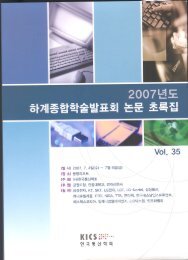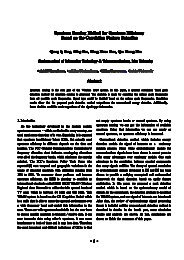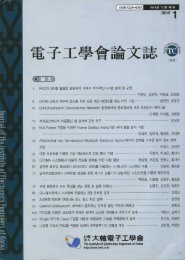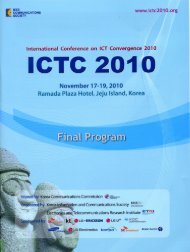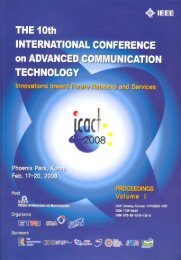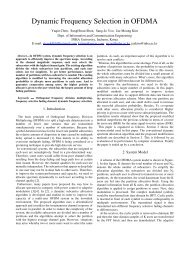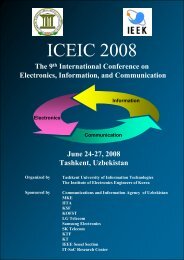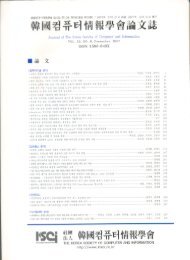Dynamic Frequency Allocation Based On Graph Coloring and Local ...
Dynamic Frequency Allocation Based On Graph Coloring and Local ...
Dynamic Frequency Allocation Based On Graph Coloring and Local ...
You also want an ePaper? Increase the reach of your titles
YUMPU automatically turns print PDFs into web optimized ePapers that Google loves.
<strong>Dynamic</strong> <strong>Frequency</strong> <strong>Allocation</strong> <strong>Based</strong> <strong>On</strong> <strong>Graph</strong> <strong>Coloring</strong> <strong>and</strong> <strong>Local</strong><br />
Bargaining for Multi-Cell WRAN System<br />
Abstract—WRAN system is a new st<strong>and</strong>ard under<br />
establishment to improve the efficiency of spectrum utilization<br />
<strong>and</strong> spectrum allocation scheme is one of its key techniques. In<br />
this paper, one spectrum allocation scheme called “pre-allocation<br />
<strong>and</strong> local bargaining” is proposed to avoid intra-cell <strong>and</strong> inter-cell<br />
co-channel interference among users. <strong>Based</strong> on color sensitive<br />
graph coloring problem <strong>and</strong> local bargaining, our scheme has the<br />
ability to guarantee the fairness among users <strong>and</strong> satisfy the<br />
user’s minimum requirement of spectrum b<strong>and</strong>width.<br />
Index terms—dynamic spectrum allocation, color sensitive<br />
graph coloring, local bargaining, WRAN system<br />
A. INTRODUCTION<br />
In conventional fixed spectrum allocation schemes, to<br />
eliminate interference between different wireless<br />
technologies, policies allocate a fixed spectrum splice to<br />
each wireless technology. The static spectrum<br />
assignment leads to underutilization of electromagnetic<br />
resource. Cognitive Radio (CR) [1], based on softwaredefined<br />
radio, has been proposed as the technology to<br />
improve the efficiency of the spectrum. In CR, spectrum<br />
utilization is significantly improved by making it<br />
possible for a secondary user to access a spectrum hole<br />
unoccupied by the primary user at the right location <strong>and</strong><br />
time. <strong>Based</strong> on the proposed CR technique, the IEEE<br />
802.22 WRAN st<strong>and</strong>ard is being established. WRAN<br />
system utilizes the spectrum holes of the DTV service,<br />
of which the operating spectrum b<strong>and</strong> is between<br />
54MHz <strong>and</strong> 862MHz. This st<strong>and</strong>ard is intended to<br />
enable deployment of interoperable 802 multivendor<br />
wireless regional area network products, to facilitate<br />
competition in broadb<strong>and</strong> access by providing<br />
alternatives to wireline broadb<strong>and</strong> access <strong>and</strong> extending<br />
the deployability of such systems into diverse<br />
geographic areas, including sparsely populated rural<br />
areas, while preventing harmful interference to<br />
incumbent licensed services in the TV broadcast b<strong>and</strong>s<br />
[2]. Sensing <strong>and</strong> dynamic frequency selection are two<br />
key techniques of WRAN system. During sensing<br />
procedure, necessary information such as the available<br />
spectrum information is assembled <strong>and</strong> then dynamic<br />
frequency selection is processed. The objective of our<br />
dynamic frequency selection is not only maximizing the<br />
spectrum utilization <strong>and</strong> also guaranteeing the fairness<br />
1-4244-0574-2/06/$20.00 (C)2006 IEEE<br />
Yuqin Chen, Ning Han, SungHwan Shon, <strong>and</strong> Jae Moung Kim<br />
Graduate School of IT <strong>and</strong> Telecommunication<br />
INHA University, Incheon, Korea<br />
among users, which means each user should be assigned<br />
at least the minimum required b<strong>and</strong>width.<br />
To achieve our target, dynamic spectrum allocation<br />
scheme in Ad-hoc networks is used for reference, the<br />
channel assignment problem is reduced to a graph multicoloring<br />
problem by mapping each channel into a color<br />
[3][4]. This topology-optimized allocation algorithm<br />
begins with no prior information, <strong>and</strong> assigns each user<br />
an optimal assignment. In our work, to avoid intra- <strong>and</strong><br />
inter-cell co-channel interference among users, the graph<br />
coloring method via local bargaining is adopted <strong>and</strong> an<br />
allocation procedure is proposed to provide the fairness<br />
among users <strong>and</strong> reduce the complexity caused by new<br />
arrival <strong>and</strong> mobile users.<br />
We propose an allocation procedure called “preallocation<br />
<strong>and</strong> local bargaining” in this paper. In the<br />
beginning, necessary information such as the users’<br />
position information <strong>and</strong> the available channel<br />
information should be assembled by initialization. After<br />
initialization, all users are pre-allocated some channels<br />
according to the color sensitive coloring graph.<br />
Unfortunately, it is probable that some users cannot<br />
achieve enough channels to satisfy its minimum<br />
transmission data rate. To avoid the unfairness among<br />
users, local bargaining is processed then in order to meet<br />
the minimum required b<strong>and</strong>width for all users.<br />
B. BACKGROUND OF SPECTRUM ALLOCATION<br />
1st. Assumptions<br />
We assume that the available spectrum is divided into<br />
a set of spectrum b<strong>and</strong>s, <strong>and</strong> that b<strong>and</strong>s differ from each<br />
other in b<strong>and</strong>width <strong>and</strong> transmission range. We also<br />
assume that spectrum b<strong>and</strong>s are orthogonal, <strong>and</strong> that<br />
users can utilize a number of spectrum b<strong>and</strong>s at one time.<br />
It is also assumed that the users (CPE in WRAN case)<br />
have assembled the available spectrum information<br />
through sensing procedure. The users in the same cell<br />
cannot transmit data between base station by the same<br />
b<strong>and</strong> simultaneously due to the intra-cell co-channel<br />
interference. What’s more, users from adjacent cells<br />
locating within a constrained distance also suffer<br />
conflicts when they select the same channels at the same<br />
time. To solve this, a simplified interference metric is
applied to represent this co-channel interference<br />
problem, <strong>and</strong> then a proposed spectrum allocation<br />
procedure is operated.<br />
The essence of spectrum allocation is to assign<br />
appropriate spectrum b<strong>and</strong>s among users so that they<br />
can coexist. In this paper, our objective is to<br />
successfully allocate spectrum b<strong>and</strong>s to users without<br />
conflicts in order to satisfy the minimum transmission<br />
data rate requirement in the WRAN system.<br />
2nd. Problem Model <strong>and</strong> Definitions<br />
We consider the case where the collection of available<br />
spectrum ranges forms a spectrum pooling, divided into<br />
non-overlapping orthogonal channels. We assume in one<br />
cell N users indexed from 0 to N-1 competing for M<br />
spectrum channels indexed 0 to M-1. Each user,<br />
according to its particular geometric position <strong>and</strong><br />
environment, has its own spectrum pooling. We<br />
modeled the system as mentioned in the WRAN<br />
st<strong>and</strong>ard requirement, the total spectrum b<strong>and</strong>s are<br />
between 54MHz <strong>and</strong> 862MHz, divided into 6MHz subb<strong>and</strong>s<br />
by DTV users. Other primary users also include<br />
wireless microphone users <strong>and</strong> medical telemetry users,<br />
etc. The secondary users obtain their environment<br />
information through sensing technique, consisting of<br />
global geometric position <strong>and</strong> available spectrum<br />
pooling information. Each user selects appropriate<br />
communication channels <strong>and</strong> adjusts transmit power<br />
accordingly to avoid interfering with primaries. The<br />
spectrum access problem becomes a channel allocation<br />
problem such as obtaining a conflict free channel<br />
assignment for each user which satisfies the minimum<br />
transmission data rate requirement.<br />
1. Channel availability L(n).<br />
{ lm, n lm,<br />
n { 0,1}<br />
}<br />
Γ = ∈ is a M by N binary<br />
M × N<br />
matrix representing the channel availability:<br />
l = 1 if <strong>and</strong> only if channel m is available at<br />
m, n<br />
user n. In general, l m, n = 0 when channel m is<br />
occupied by a primary user who conflicts with<br />
user n, so that the transmissions of n on this<br />
channel will interfere with the primary’s activity<br />
if they use channel m concurrently. Let<br />
{ m, n }<br />
L( n) = 0 ≤ m ≤ M − 1 l = 1 be the set of<br />
channels available at n[3].<br />
2. Interference constraints C.<br />
{ n, k n, k 0,1 }<br />
Let C c c { }<br />
= ∈ , a N by N matrix,<br />
N× N<br />
represents the interference constraints among<br />
c = , users n <strong>and</strong> k would interfere<br />
users. If , 1<br />
n k<br />
with each other if they use the same channel.<br />
The interference constraint depends on the<br />
signal strength of transmission <strong>and</strong> the distance<br />
between users. A simple mode of interference<br />
constraints is the binary geometry metric, i.e.<br />
two users coming from different cells conflict if<br />
they are within π distance from each other.<br />
3. Conflict free assignment A.<br />
{ m, n m, n { 0,1}<br />
}<br />
A = a a ∈ where a , = 1<br />
M × N<br />
denotes that spectrum b<strong>and</strong> m is assigned to user<br />
n, otherwise 0. A satisfies all the constraints<br />
defined by C, that is ,<br />
a + a ≤ 1, if c = 1, ∀ n, k < N, m < M.<br />
m, n m, k n, k<br />
m n<br />
Let Λ N , M denotes the set of conflict free<br />
spectrum assignments for given set of N users<br />
<strong>and</strong> M spectrum b<strong>and</strong>s.<br />
4. Maximum <strong>and</strong> minimum required b<strong>and</strong>width.<br />
Most of previous spectrum assignment methods<br />
considered providing optimum spectrum<br />
utilization, while, in our case, the fairness<br />
among users is more important. So our model’s<br />
objective is to satisfy each user’s minimum<br />
required b<strong>and</strong>width.<br />
3rd. Color-Sensitive <strong>Graph</strong> <strong>Coloring</strong><br />
In [4], it is shown that by mapping each channel into a<br />
color, the channel assignment problem can be reduced to<br />
a graph multi-coloring problem. We define a<br />
G = U, E , L where U is a set of<br />
bidirectional graph ( )<br />
C B<br />
vertices denoting the users that share the spectrum, B L<br />
represents the available spectrum b<strong>and</strong>width, or the<br />
color list at each vertex, <strong>and</strong> E C is a set of undirected<br />
edges between vertices representing interference<br />
constraints between two vertices. For any two distinct<br />
vertices u, v ∈ U , a m-color edge between u <strong>and</strong> v, is in<br />
EC if <strong>and</strong> only if , , 1<br />
u v m<br />
c = . Hence, any two distinct<br />
vertices can have multiple colored edges between them.<br />
We define the color m specific degree of a vertex u, i.e.,<br />
Du,m to represent the number of neighbors that are color<br />
m mutually constrained with u (those who can not use m<br />
if u uses color m). It is also a relatively good measure of<br />
the impact (to neighbors) when assigning a color to a
vertex. The equivalent graph coloring problem is to<br />
color each vertex using a number of colors from its color<br />
list, such that if a color m edge exists between any two<br />
distinct vertices, they can’t be colored with m<br />
simultaneously. We name this the color-sensitive graph<br />
coloring (CSGC) problem [4].<br />
Fig. 1 illustrates an example of CSGC graph. There<br />
are five colors available. The numbers outside the<br />
brackets attached to each node denote the colors<br />
assigned to that node, while the numbers inside the<br />
brackets denote the available color list of each node.<br />
Fig.1. An example of GMC graph<br />
A CSGC problem is to color each vertex using a<br />
number of colors from its color list, <strong>and</strong> find the color<br />
assignment that maximizes system utility. The coloring<br />
is constrained by that if an edge exists between any two<br />
distinct vertices, they can’t be colored with the same<br />
color. Most importantly, the objective of coloring is to<br />
maximize system utility. This is different from<br />
traditional graph color solutions that assign one color<br />
per vertex. Notice that the solution to this graph coloring<br />
problem is to maximize system utility for a given graph,<br />
i.e. a given topology <strong>and</strong> channel availability. This<br />
characterizes the optimal solution for a static<br />
environment.<br />
The optimal coloring problem is known to be NPhard.<br />
Efficient algorithms to optimize spectrum<br />
allocation for a given network topology exist. In [4], the<br />
authors presented a set of sequential heuristic based<br />
approaches that produce good coloring solutions. The<br />
algorithm starts from the empty color assignment <strong>and</strong><br />
iteratively assigns colors to vertices to approximate the<br />
optimal assignment. In each stage, the algorithm labels<br />
all the vertices with a non-empty color list according to<br />
some policy-defined labeling. The algorithm picks the<br />
vertex with the highest valued label <strong>and</strong> assigns the<br />
color associated with the label to the vertex. The<br />
algorithm then deletes the color from the vertex’s color<br />
list, <strong>and</strong> from the color lists of the constrained neighbors.<br />
The color list <strong>and</strong> the interference constraint of a vertex<br />
keep on changing as other vertices are processed, <strong>and</strong><br />
the labels of the colored vertex <strong>and</strong> its neighbor vertices<br />
are modified according to the new graph. The algorithm<br />
can be implemented using a centralized controller who<br />
observes global topology <strong>and</strong> makes decisions or<br />
through a distributed algorithm where each vertex<br />
performs a distributed voting process. Results in [4]<br />
show that the heuristic based algorithms perform<br />
similarly to the global optimum (derived off-line for<br />
simple topologies), <strong>and</strong> the centralized <strong>and</strong> distributed<br />
algorithms perform similarly.<br />
C. SPECTRUM ALLOCATION ALGORITHM FOR MULTI-<br />
CELL WRAN SYSTEM<br />
1st. Spectrum <strong>Allocation</strong> for Multi-cell WRAN<br />
System<br />
In WRAN system case, the users in the same cell<br />
cannot select the same spectrum b<strong>and</strong>width at the same<br />
time. In addition, the users coming from adjacent cells<br />
also suffer co-channel interference if they locate within<br />
the constrained distance from each other. Therefore, we<br />
consider the users as the vertices in the coloring graph.<br />
The users from adjacent cells which locate within the π<br />
distance are connected by the constraints with the edge.<br />
Fig. 2 illustrates the CSGC example of multi-cell<br />
WRAN system. At the boundaries of the cells, users<br />
coming from different cells conflict each other while<br />
selecting the same spectrum at the same time.<br />
Fig.2. CSGC example of multi-cell WRAN system<br />
The spectrum allocation for multi-cell WRAN system<br />
begins from the central cell <strong>and</strong> then to the outer cells.<br />
And an allocation approach called “pre-allocation <strong>and</strong><br />
local bargaining” is applied. In the pre-allocation stage,<br />
all users try to select the maximum required number of<br />
spectrum b<strong>and</strong>width. Actually, probably many users<br />
cannot be assigned enough b<strong>and</strong>width. To satisfy the<br />
minimum required b<strong>and</strong>width of all users, the users<br />
allocated with less than minimum required b<strong>and</strong>width<br />
have the right to borrow some b<strong>and</strong>width from its<br />
neighbors locating within the constraint distance.<br />
Detailed description of the spectrum allocation is<br />
following:
1. Initialization.<br />
In the beginning of spectrum allocation,<br />
necessary information, including the users’<br />
global position information <strong>and</strong> the available<br />
channel information, etc, needs to be assembled<br />
by the base station through any kind of detection<br />
technique, or sensing technique. <strong>Based</strong> on the<br />
global position information, the color-sensitive<br />
coloring graph can be drawn by the base station<br />
<strong>and</strong> the users constrained by co-channel<br />
interference are connected by edges described<br />
by Fig. 1. And then we calculate the value<br />
the number of connected user<br />
ratio =<br />
the number of total availableb<strong>and</strong>s<br />
of each user. The numerator denotes the number<br />
of competing users <strong>and</strong> the denominator shows<br />
the available spectrum source it has. Therefore,<br />
larger value means worse situation for allocation<br />
<strong>and</strong> this is our policy-defined labeling<br />
mentioned in part B.<br />
2. Pre-allocation.<br />
The allocation operation is applied cell by cell,<br />
<strong>and</strong> starts from the central cell. During this<br />
operation, each user tries to achieve the<br />
maximum spectrum b<strong>and</strong>width as it requires.<br />
According to the heuristic approach, the user<br />
with highest labeling is picked up first to<br />
allocate channels from the available spectrum<br />
pooling. The algorithm then deletes the<br />
allocated spectrum b<strong>and</strong>s from the spectrum<br />
pooling of itself <strong>and</strong> of its constrained neighbors.<br />
In the following allocation loops, the user with<br />
the largest labeling among the left users is<br />
subsequently selected to allocate as before. This<br />
spectrum allocation procedure goes on until all<br />
users coming from all cells have been assigned<br />
appropriate spectrum channels.<br />
3. <strong>Local</strong> bargaining among users.<br />
When the pre-allocation operation is finished, it<br />
is probable that some users are assigned as many<br />
channels as enough to satisfy the maximum<br />
b<strong>and</strong>width requirement <strong>and</strong> meanwhile the<br />
others are not able to satisfy the minimum<br />
desired b<strong>and</strong>width. To improve the fairness,<br />
local bargaining operation among users is<br />
proposed. The users without enough channels<br />
have the opportunity <strong>and</strong> right to borrow<br />
channels from their constrained neighbors. The<br />
base station will check the situation <strong>and</strong> judge<br />
who should lend channel source to them. This<br />
procedure improves the efficiency of fairness.<br />
When selecting channels from the available spectrum<br />
pooling, the algorithm should better select spectrum subb<strong>and</strong>s<br />
from different 6MHz DTV b<strong>and</strong>s. The reason is to<br />
avoid shutting down all the transmission between one<br />
user <strong>and</strong> the base station when primary DTV user<br />
appears in one 6MHz b<strong>and</strong>.<br />
D. SIMULATION RESULTS<br />
We conduct computational simulation to evaluate our<br />
spectrum allocation approach for multi-cell WRAN<br />
system. We simulate a 19 multi-cell system, <strong>and</strong> in each<br />
cell, hundreds of users are transmitting data with base<br />
station. Co-channel interference from neighboring cells<br />
has a significant effect on the performance of the sample<br />
cell. Because the boundary cells suffer co-channel<br />
interference from fewer adjacent cells, it would show<br />
better performance than inner-located cells. Due to the<br />
performance difference between the inner-located cells<br />
<strong>and</strong> boundary cells, only the inner 7 cells are considered<br />
to evaluate the system performance. Each user has its<br />
own condition, including geometric position <strong>and</strong><br />
information of available spectrum pooling. We further<br />
abstract the network into a conflict graph where each<br />
vertex represents a working user. The parameters in<br />
simulation are given as Tab. 1.<br />
Tab.1 Simulation Parameters<br />
User number per cell 700 ~ 1600<br />
Maximum required channel number 10<br />
Minimum required channel number 5<br />
Available channel number for each 21~70<br />
user<br />
Cell coverage 30Km<br />
Constrained distance 0.5*30Km<br />
Block Probability<br />
1.00E+00<br />
1.00E-01<br />
Block Probability vs. user number/cell<br />
1.00E-02<br />
700 800 900 1000 1100 1200 1300 1400 1500 1600<br />
user number<br />
Fig.3 Block Probability vs. user number in each cell
Block Probability<br />
1.00E+00<br />
1.00E-01<br />
Block Probability vs.Maximum Required Channel Number<br />
1.00E-02<br />
10 15 20 25 30 35 40 45 50 55<br />
Maximum Available Channel Number<br />
Fig.4 Block Probability vs. maximum required<br />
channel number (user number/cell =800)<br />
Block Probability<br />
1.00E+00<br />
1.00E-01<br />
1.00E-02<br />
Block Probability vs.Minimum Required Channel Number<br />
1 2 3 4 5 6 7 8 9<br />
Minimum Required Channel Number<br />
Fig.5 Block Probability vs. minimum required<br />
channel number (user number/cell =800)<br />
In our work, we consider only the spectrum allocation<br />
model <strong>and</strong> procedure without channel quality. So the<br />
simulation is only related to the allocation result,<br />
including the block probability versus the user number<br />
per cell, the maximum required channel number <strong>and</strong> the<br />
minimum required channel number. Fig. 3 shows the<br />
trend of block probability as user number per cell<br />
changing. Fig. 4 <strong>and</strong> Fig. 5 illustrate that the block<br />
probability is related to minimum required channel<br />
instead of maximum required channel because the<br />
algorithm guarantees the minimum required channel of<br />
users.<br />
E. CONCLUSION AND FURTHER WORK<br />
In this paper, we propose a spectrum allocation<br />
scheme called “pre-allocation <strong>and</strong> local bargaining” for<br />
multi-cell WRAN system. This scheme adopts the color<br />
sensitive graph coloring problem, regarding the users<br />
from different cells which will conflict with each other<br />
when they locate within constrained distance as the<br />
vertices in the graph. And each vertex should select<br />
appropriate colors without interfering with other users<br />
connected with it by constrained edge.<br />
In our scheme, the first stage is named “preallocation”,<br />
during which it is tried to allocate all users<br />
spectrum b<strong>and</strong>s as many as maximum requirement.<br />
Actually, some users would fail to get enough spectrum<br />
b<strong>and</strong>s, therefore, the second stage called “local<br />
bargaining” is processed to reduce the block probability<br />
or guarantee the minimum b<strong>and</strong>width requirement. The<br />
“local bargaining” has other advantages that it is capable<br />
to reduce the complexity for new arrival <strong>and</strong> mobile<br />
users.<br />
To evaluate our proposed scheme, computer<br />
simulation has been done. However, due to the lack of<br />
consideration about channel environment effects, our<br />
simulation results only give us an impression about the<br />
efficiency on block probability. To evaluate this model<br />
more precisely, other parameters should be considered<br />
during simulation such as the frequency domain channel<br />
response [5]. Therefore, adding <strong>and</strong> considering the<br />
practical channel effects is our further work.<br />
REFERENCES<br />
[1] Simon Haykin, “Cognitive radio: Brain-empowered wireless<br />
communications ”, in IEEE journals on selected areas in<br />
communications, vol.23, No. 2, February 2005, pp. 201-220.<br />
[2] Carl R. Stevenson, Carlos Cordeiro, Eli Sofer, Gerald Chouinard,<br />
“Functional requirements for the 802.22 WRAN st<strong>and</strong>ard”, Mar, 2006.<br />
[3] Lili Cao, Haitao Zheng, “Distributed spectrum allocation via local<br />
bargaining”, in IEEE SECON., 2005, pp.475-486.<br />
[4] Haitao Zheng, Chunyi Peng, “Collaboration <strong>and</strong> fairness in opportunistic<br />
spectrum access,” in Proc. 40 th annual IEEE international conference on<br />
communications., Jun, 2005, pp. 3132-3136.<br />
[5] Yuqin Chen, SungHwan Shon, Sang-Jo Yoo, Jae Moung Kim, “<strong>Dynamic</strong><br />
frequency selection in OFDMA”, ICACT,2006.



